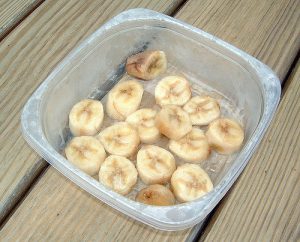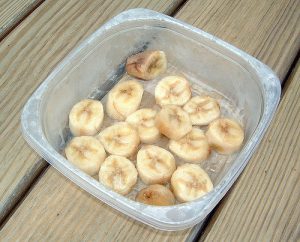You likely already keep a supply of basics like vegetables, fruits, meats, poultry, and grains in your freezer.

Some items keep better in the freezer than others, as you’ve probably noticed by now.
However, there some items that can be frozen that might surprise you.
Here’s a list of 20 perishable foods you can freeze.
- Nuts (and flours made from nuts): Nuts can go rancid very quickly because of their high oil content. To freeze peanuts, walnuts, pecans, cashews, macadamia nuts, hazelnuts, and almonds (shelled or unshelled) and place in reusable freezer bags. Nuts can also be frozen in glass containers. You can freeze nut butters, too!
- Seedless grapes: Wash and dry small clusters and freeze them in bags. Or, remove the grapes from the stems and place them on a baking sheet (lined with parchment paper) in a single layer, and then freeze until firm. Then, transfer the grapes into airtight containers and put them back in the freezer.
- Bananas: When they reach your desired level of ripeness, peel bananas and freeze them in bags or freezer-safe containers.
- Fresh berries: Place clean berries on a lined cookie sheet first – this way, they are less likely to stick together. Once the berries are frozen, transfer them to freezer bags.
- Fresh vegetables: Chop up onions, peppers, and spinach and freeze them flat in bags. Note: Vegetables with high water content (like lettuce, celery, and cucumbers) do not freeze well.
- Fresh herbs: Wash and pat your herbs dry, then chop them into desired portions. Spread the chopped herbs on a cookie sheet. Cover it with plastic wrap and place in your freezer. Once the herbs are frozen, remove them from the sheet and put them in freezer bags. Or, finely chop fresh herbs and place them in an ice cube tray with a lid. Freeze, and use the cubes as needed in soups and other recipes.
- Tomato paste, pumpkin puree, and sauces: Freeze in ice cube trays. Once frozen, pop the cubes out and put them in freezer bags.
- Soups and chili: Cool completely, and transfer to freezer-safe containers. Be sure to leave about a cup’s worth of empty space at the top to allow for expansion.
- Avocado: These buttery green fruits CAN be frozen, but the texture will change. You probably won’t want to eat an avocado that has been frozen by itself, but it can be used to make guacamole, dressings, or dips. To freeze avocados, wash them, cut them in half, and peel them. You can freeze them as halves or puree them and freeze in airtight containers.
- Corn on the cob: Farm-fresh corn on the cob can be frozen as is (husk and all!) in an airtight package. For corn that is less fresh, husk the ears and blanch them in boiling water from 7 to 11 minutes. Cool quickly, dry, and seal in an airtight packaging before freezing.
- Mushrooms: You can freeze raw or cooked mushrooms, but cooked mushrooms bring better results. Freeze them on a baking sheet first to keep them separate, then transfer to a freezer bag or container.
- Mashed potatoes: Place scoops of mashed potatoes onto a baking sheet lined with parchment paper. Freeze until hard, and then transfer the scoops into a freezer bag. These will keep in the freezer for at about 2 months.
- Rice and other grains: Raw and cooked rice can both be frozen. Place the rice in airtight containers. Cooked rice must be put into the freezer the same day. Cool the rice before freezing. Thaw cooked rice in the refrigerator, and heat it in the microwave or on the stove, adding water as needed. Don’t reheat more than once, and do not freeze leftover carryout rice, as it may have already been frozen before it got to you.
- Pasta: Place cooked pasta in a freezer bag, lay flat, and squeeze out all the air. Reheat the pasta by running hot water over the bag for a few minutes.
- Milk and buttermilk: Fresh milk can be frozen, believe it or not. Remove a little from the top of the container before freezing to allow room for expansion. To use frozen milk, let it thaw, and then shake well before opening to make sure any solids are remixed. Use within a couple of days. If the texture of the milk you have frozen is not ideal for drinking (sometimes it can be grainy), use it in recipes instead.
- Yogurt: Freeze individual serving cups. You can eat these right from the freezer for a frosty treat, or let them defrost in the refrigerator before consuming.
- Butter: Can be frozen in its original packaging or placed in a freezer bag or other freezer-safe container.
- Eggs: Crack eggs into a freezer bag and freeze flat, or crack them into ice cube trays (you can freeze yolks and whites separately with this method if desired). Thaw them in the refrigerator before use.
- Cheese: This generally works best with hard cheeses. You can freeze cheese in blocks, but shredding it first will provide the best results. Freeze in airtight bags or containers. Thaw in the refrigerator.
- Bacon (uncooked): Remove from original packaging, wrap individual portions (3-4 slices) in parchment paper, and place in freezer bags. Bacon defrosts quickly at room temperature.
No matter what you decide to freeze, be sure to label the packaging with the name of the item and the date it was frozen.
While foods that are properly frozen can usually be stored indefinitely, the quality can diminish over time. For a freezer storage chart (and additional freezing tips), please see Using Your Freezer as a Long Term Food Storage Solution.
This is a guest post from Ready Nutrition by Lisa Egan.
